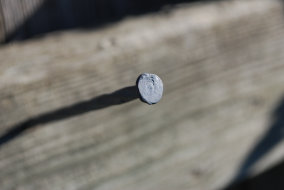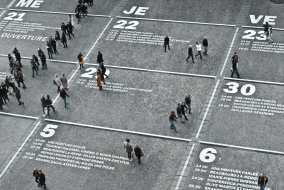Book summary of
Made to Stick

You can only use 10 percent of your brain! Ever wonder why is this idea sticky? (even though it's false?) "Made to stick" finds six qualities in all sticky ideas. Add them to your idea, and it instantly becomes more sticky!
They spell like SUCCESS:
- Simple
- Unexpected
- Concrete
- Credible
- Emotional
- Stories
Sticky ideas are easily understood and remembered. And they're able to affect people's opinions and behaviour.
1. Make it Simple
If you argue ten points, no one would remember any, even if they're good. To make you idea sticky, you should make it simple and strip it down to its core.
Have a Commander's Intent:
In the military, they say no plan survives contact with the enemy. Any plan can be made useless by your enemy's unpredictable moves. So the Army invented Commander's Intent. Which is the mission's core.
CI can be simple as: "break the enemy's will." It gives leaders and soldiers the ability to improvise tactics as needed, while adhering to the common intent.
Southwest Airlines is a very successful airline. One reason for that is having a core: We're the low-fare airline. It's a simple idea, and it helps guide employee actions. If you're an employee who is asked to decide whether to add a pricey chicken Caesar salad to the airline's menu because customers requested it, you'll reject the idea because it doesn't help being low-fare.
Prioritize the lead:
In journalism, the lead of a story is its first sentence. And it should contain its most essential elements. When writing your idea, you shouldn't get lost in the details, you should prioritize your lead.
The daily record is a very successful newspaper with extreme local focus. When asked why they're so successful, they reply with three reasons: "Names, Names, Names!" For them, adding a local person's name is more important than nuclear explosions in other communities. Having a clear core and prioritizing it helps employees make everyday decisions that aligns with paper's intent.
Use a schema
An easy way to make a new idea simpler is to use a concept your audience already know: a schema. You can teach students about the atom by saying "Electrons orbit the nucleus, much like planets orbit the sun."
Other examples:
- Pomelo is a super-sized grapefruit.
- The movie Speed is Die Hard on a bus.
- The movie Alien is Jaws on a spaceship.
Use generative analogies
Using analogies inspires novel thinking. Disneyland calls its employees "cast members." This inspires employees to think: "When we're walking in the park, we're on-stage." "We could never have a cigarette mid-scene."
2. Make it Unexpected
Unexpected ideas stick to our minds because it surprises us and gets our attention.
Getting attention
Break a pattern
The easiest way to get people's attention is to break a pattern.
A minivan TV ad starts: "Introducing the all-new Enclave". The whole family is sitting in the car, and dad starts the car and says "It's the minivan to the max." The ad continues with the minivan moving through streets, while the narrator is explaining its features. At an intersection, a speeding car barrels and the minivan makes a terrifying collision. "You didn't see that coming?" The ad was really created by the transportation department! This ad is unexpected. it breaks the pattern for car commercials.
Find the unexpected
To make your idea sticky, you need to avoid being common sense. "The low-fare airline" is common sense to employees, so they break expectations by saying they don't add chicken salad even if customers want it. "Names, names, names" is common sense for a local newspaper, so they surprise us by prioritizing the local person's name than nuclear explosions!
To make it unexpected, you need to find what are the unexpected consequences of your core message.
Nordstorm is a store known for outstanding customer service, even at the expense of efficiency. To train employees, they tell unexpected stories like "the Nordie who happily gift wrapped products a customer bought at Macy's." "The Nordie who refunded money for a set of tire chains, although Nordstorm doesn't sell tire chains!"
Keeping attention
Surprise gets our attention. Mystery and Interest keeps it.
If you want to teach students about the rings of Saturn, here is a good way to start: "Why does the rings of Saturn exist? Nothing else like them in out solar system! What are they made of? How could three groups of scientists come to very different conclusions?!" Then let the answer unfold like the plot of a mystery.
Aha! moments are powerful, especially if preceded by the Huh? experience.
The Gap Theory of curiosity: Curiosity happens when we want to fill a gap in our knowledge. When we want to know something but don't, it's like having an itch that we need to scratch. That's why sensational news can start with: "There is a new drug sweeping teenagers, and it may be in your own medicine cabinet!"
To make your Gap Theory work even better, make people commit to a prediction! The simple act of committing makes people more engaged and curious about the outcome. To know if they're right or wrong!
3. Make it Concrete
If you want your ideas to be sticky, avoid being abstract! Language is often abstract, but life is not!
"World-class customer service" is abstract, A Nordie ironing a customer's shirt is concrete.
Avoid abstract
East Asian children outperform children in Math. But what are Asian schools doing differently? 3 + 2 + 1 is meaningless to a three-year old. So, they explain it like this: "There are three kids playing ball. Two more came later, then one more joined them. How many are playing now?" Asian Math teachers emphasize things that are concrete and familiar.
Concreteness sticks, bicycle and avocado are easier to visualize and remember than justice and personality.
Fight the Curse of Knowledge
The difference between an expert and a novice is the ability to think abstractly. When you become an expert in chess, you'll more likely to talk about chess strategies rather than the act of moving bishops diagonally. When communicating, it's important to fight your curse of knowledge by being concrete.
One thing that made Sony successful is the pocketable radio idea. It was simple, unexpected (at the time, radios was like furniture), and concrete. It gave Sony engineers a clear and ambitious goal to achieve.
Kennedy said to the American people: "our goal is to land a man on the moon and return him safely to earth". It's simple, unexpected (people didn't walk on the moon), and concrete.
4. Make it Credible
What makes people believe ideas? To persuade people into believing an idea, you and your idea should feel credible.
Add Authority
People who spread rumours know this! When it is health related, they attach FDA to it! It instantly becomes more believable.
If you can't find expert or celebrity endorsement, you can use anti-authority!
Use Anti-authority
If you're trying to teach people about the dangers of smoking, it can be highly effective to use anti-authority figures, like sharing smoker stories!
Use vivid details
Adding particular details to a story can make it more credible. Researchers have found that irrelevant details in a story can convince jury members in a trial. In a test, the story that contained "using a Star Wars toothbrush that looks like Darth Vader" was more believable. Even though it was irrelevant to the case.
Make statistics relatable
To show the devastating nuclear arsenal we have, doing this is much better than saying we have 5,000 nuclear warheads:
Drop a BB into an empty bucket. It makes a loud noise and say "This is Hiroshima bomb." Then drop 5,000 of them into the same bucket! and shout "This is what we have now." The noise will be terrifying, and your idea will stick!
In an organization saying: Only 37% of the org have understand what we're trying to achieve is worse than saying If a soccer team had these scores, only 4 of the 11 players would know which goal is theirs! Make it relatable.
Pass the big test
If you want your shipping company to be credible, you can use the fact that you handled Harry Potter delivery, which is extremely complicated to do. If you want to say that your textile products are free from hazardous chemicals. Say that you have edible textiles. They're safe enough to eat!
Make it testable
One Wendy campaign features a woman going to another store and says "Where's the beef?!" The commentator then says that Wendy has more beef than Whopper and Big Mac. The ad showed a real Wendy advantage, and encouraged people to go test that by themselves! The ad was very successful!
5. Make it Emotional
Mother Teresa: If I look at the mass, I will never act. If I look at the one, I will.
Avoid the analytical hat
In a study, a group was asked mathematical questions to analyze, and a second group was asked a question that made them feel. When they were asked to donate to a case later, the second group donated much more! Just putting our analytical hat makes us react to emotional appeals differently.
Tap into things we care about
Sportsmanship was a powerful idea in sports, but it started to be viewed as consolation prizes for losers who just don't do bad things. It lost the ability to motivate good behaviour. The founder of Positive Coaching Alliance rebranded it to Honoring the game. People care about the game, so it made it feel more patriotic. It implies that you owe your game some respect. The result was a dramatic reduction in basketball fouls!
In 1980s, Texas had a serious litter problem. The state was spending millions per year on cleanups, and the costs were rising. To solve the issue, they had to come with an emotional campaign: "Don't Mess with Texas!" TV ads featured beloved Texan athletes and musicians. The slogan was smart because it appeals to Texans identity. Within one year, litter declined by 29 percent!
6. Use Stories
Stories are retold because they contain wisdom. Stories teach us and inspire us to act.
The nurse and the baby
A nurse works at an intensive-care unit for babies. She's watching a baby who suddenly turns blue-black! The medical team gathers quickly, and assumes that the baby's lung had collapsed. But the nurse thought it was a heart problem, because this color reminded her of a baby who died of a condition where air fills the sac surrounding the heart. She said "It's the heart" and tried to stop preparations for the lung operation. But the medical team pointed at the heart monitor which seems fine. She insisted and tested the heartbeat using a stethoscope. There was no sound! An X-ray confirmed the result, so they treated the baby's heart. The baby's life was saved! Turns out that the heart monitor measures electrical activity, not actual heartbeats. Heart nerves were firing, but the air in the sac around the heart prevented it from beating!
Stories like these are effective teaching tools. It warns medical personnel about relying too much on machines. And it's also inspiring to everyone!
Jared's Tale
Jared had a serious weight problem. He wore size XXXXXXL shirts. Motivated by Subway's "7 under 6" campaign, he tried a sandwich and liked it. So he developed his own "Subway diet". After three months, he dropped almost 100 pounds. The story was written in a student magazine article. The story caught the attention of Subway's marketing team, and they turned it into one of their most successful ad campaigns!
It's simple, unexpected (fast food isn't healthy), concrete, credible (anti-authority), emotional (about an individual), and it's a story of overcoming big odds.
Sometimes finding great ideas is just a matter of spotting!
Effective stories
There are three effective story plots: Challenge, Connection, Creativity.
The challenge plot: The protagonist overcomes an intimidating challenge and succeeds. (Star Wars movies)
The connection plot: The leading characters develops a relationship that bridges a gap - racial, class, religious, etc. (Romeo and Juliet)
The creativity plot: The lead makes a mental breakthrough. (An apple falls on Newton's head)

























